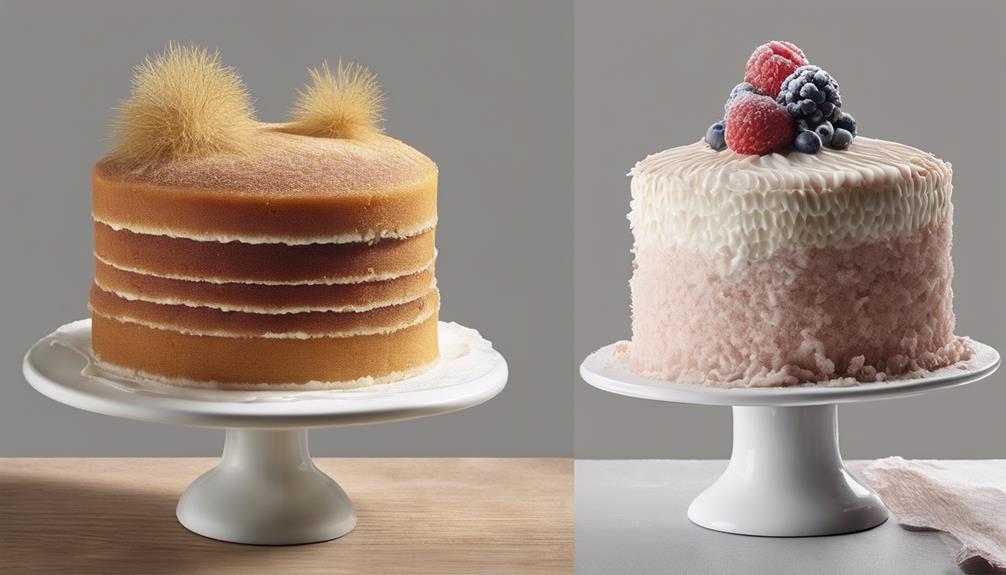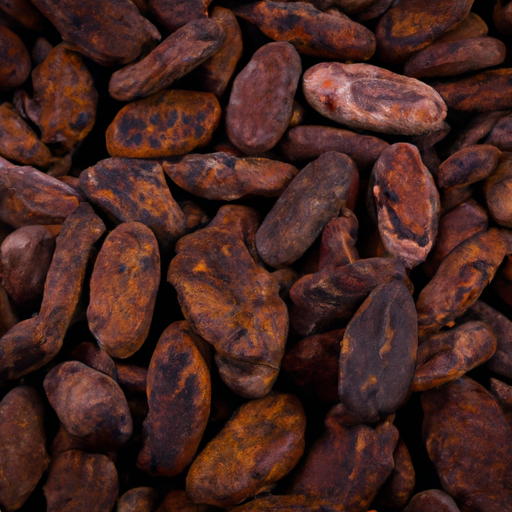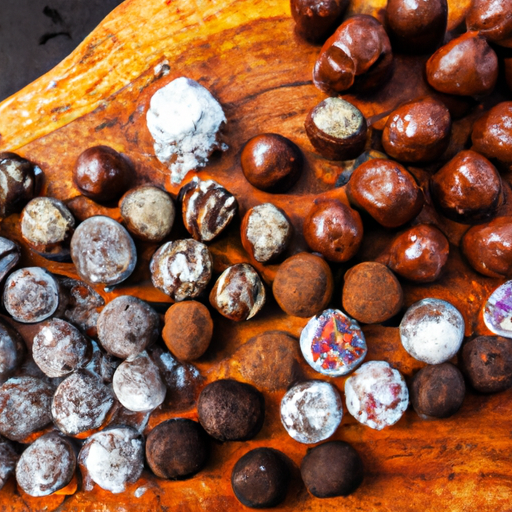When comparing sponge cake to regular cake, it’s important to note seven key differences. Firstly, sponge cakes have a higher ratio of eggs to flour, while regular cakes include butter or oil for a richer flavor. Secondly, sponge cakes have a light, easily crumbled texture with more air, while regular cakes are denser and firmer. Thirdly, sponge cakes offer a delicate, less sweet taste compared to the sweeter flavor of regular cakes. Fourthly, the lower protein content in cake flour gives sponge cakes a tender crumb, while all-purpose flour in regular cakes results in a denser texture. Fifthly, butter adds richness to regular cakes, while sugar is necessary for the light structure of sponge cakes. Sixthly, sponge cakes have a light and airy crumb structure, whereas regular cakes have a denser one.
Lastly, sponge cakes pair well with lighter frostings like whipped cream, while regular cakes complement heavy frostings like buttercream. To uncover more about these distinctions, further exploration will reveal additional insights.
Key Takeaways
- Sponge cakes use a higher ratio of eggs to flour for a light, airy texture.
- Regular cakes contain butter or oil, resulting in a denser, richer texture.
- Sponge cakes have a delicate, less sweet flavor compared to regular cakes.
- Cake flour is used in sponge cakes for a tender crumb, while regular cakes use all-purpose flour.
- Frosting choice varies; sponge cakes pair well with lighter frostings, while regular cakes suit richer ones.
Ingredients Variations
When comparing sponge cake to regular cake, the key difference in ingredients lies in their fat content and ratio of eggs to flour. Sponge cakes, unlike regular cakes, contain a higher ratio of eggs to flour. This difference in composition affects the overall texture and taste of the cakes.
Regular cakes typically include butter or oil as a fat component, contributing to a richer taste and denser texture. In contrast, sponge cakes rely on the air whipped into the eggs for structure, resulting in a lighter, delicate crumb structure.
The method used to incorporate ingredients is also distinct between the two types of cakes. While fat is creamed with sugar in regular cakes to create a moist and tender crumb, sponge cakes achieve their airy and fluffy consistency through the incorporation of whipped eggs.
These several factors in ingredient composition and method used play a significant role in defining the unique characteristics of both cake varieties.
Texture Contrasts
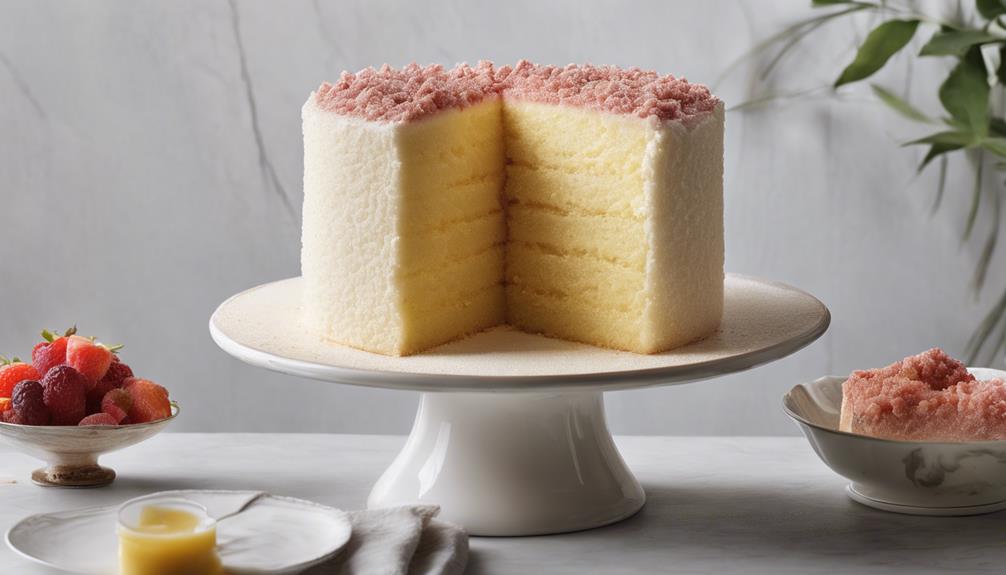
When comparing sponge cake to regular cake, one key difference lies in their texture contrasts. Sponge cakes are known for their light, easily crumbled texture that contains a large amount of air.
In contrast, regular cakes have a denser, more solid texture with less air incorporated into the batter.
Sponge Vs Regular Texture
Comparing the texture of sponge cakes to regular cakes reveals a distinct contrast in their density and crumb structure. Sponge cakes have a light and airy texture, achieved by incorporating a high amount of air into the cake batter when mixing eggs and sugar. On the other hand, regular cakes, such as butter or pound cakes, have a denser and firmer texture compared to sponge cakes. The table below summarizes the key differences in texture between sponge cakes and regular cakes:
| Aspect | Sponge Cakes | Regular Cakes |
|---|---|---|
| Density | Light and airy | Denser and firmer |
| Crumb Structure | Delicate and tender | Heavier and more compact |
| Leavening Agents | No leavening agents used | Baking powder or baking soda is used |
Moisture Levels Compared
Exploring the contrast in moisture levels between cakes and sponges reveals distinctive textural differences influenced by their unique compositions. When it comes to texture, moisture plays a vital role in determining the overall feel of the cake or sponge in your mouth. Here are four key points to keep in mind:
- Cakes become denser over time as they lose moisture, resulting in a firmer texture.
- On the other hand, sponges maintain a light and fluffy texture due to their high air content and moisture retention.
- The moisture levels in cakes contribute to their denseness, while sponges rely on moisture to stay airy.
- Understanding how moisture affects texture is essential for distinguishing between the dense nature of cakes and the airy feel of sponges.
Flavor Profiles
In sponge cakes, the flavor profile tends to be more delicate and less sweet compared to regular cakes. Sponge cakes focus on a light, airy texture that complements the subtle flavor profile, making them perfect for those who enjoy a less sugary treat. On the other hand, regular cakes, like white cakes, often taste sweeter due to the use of whole eggs or yolks, giving them a richer taste overall. The difference in flavor between these two types of cakes is influenced by various factors such as the amount of sugar, the type of flour used, and the fats incorporated into the recipe.
Let's break down the flavor profiles of sponge cakes and regular cakes in a simple table:
| Aspect | Sponge Cakes | Regular Cakes |
|---|---|---|
| Sweetness | Less sweet | Sweeter |
| Texture | Light and airy | Rich and dense |
| Flavor | Delicate, subtle | Bold and rich |
Cake Flour Usage
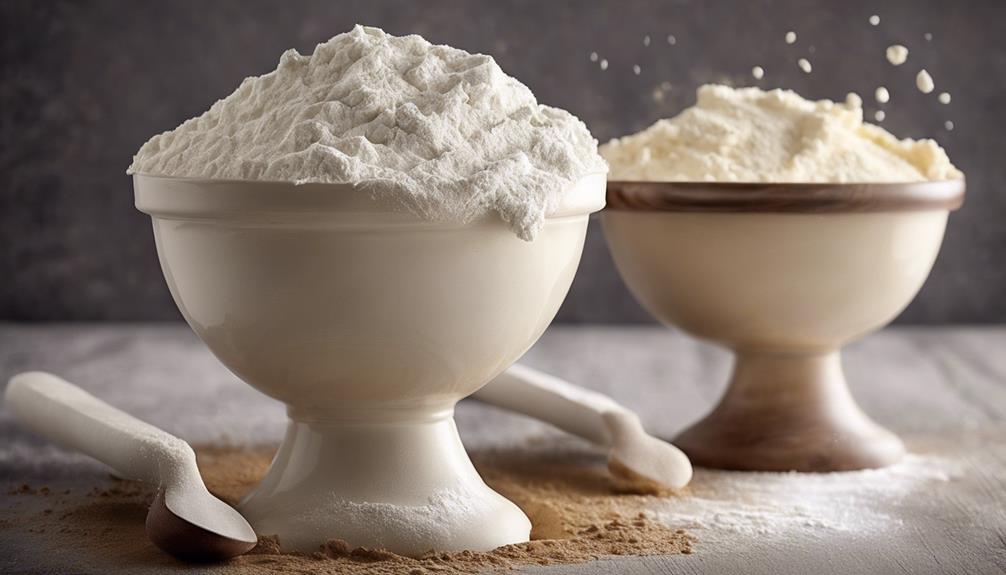
Cake flour and all-purpose flour differ in protein content, which is important for texture. Cake flour's lower protein levels yield a tender crumb in sponge cakes.
This impacts the cake's taste and texture significantly.
Flour Types Comparison
Choosing cake flour in sponge cakes plays an essential role in their distinctive delicate and soft texture due to its low protein content. When comparing flour types for cakes, here's why cake flour stands out for sponge cakes:
- Light and Airy Texture: Cake flour's low protein content helps create a light and airy texture in sponge cakes.
- Tender Crumb Structure: The low protein content in cake flour prevents gluten formation, resulting in a tender crumb structure.
- Delicate Softness: Sponge cakes require cake flour to achieve a delicate and soft texture that differs from regular cakes.
- Fine-textured Crumb: Cake flour is finely milled and bleached, producing a fine-textured crumb that enhances the overall quality of sponge cakes.
Texture Differences Explained
With its low protein content, cake flour contributes greatly to the delicate and airy texture that sets sponge cakes apart from regular cakes. The lower protein content in cake flour plays an important role in creating a tender crumb structure in sponge cakes, giving them that light and fluffy quality.
Regular cakes, on the other hand, typically use all-purpose flour, which results in a denser texture compared to sponge cakes. The soft and airy quality that defines sponge cakes is largely attributed to the use of cake flour.
Impact on Taste
When using cake flour in baking, the subtle difference in texture can greatly influence the overall taste experience of the finished product.
- Cake flour in sponge cakes contributes to a lighter texture and finer crumb structure.
- Regular cakes using all-purpose flour tend to have a denser texture compared to sponge cakes.
- Sponge cakes made with cake flour have a delicate, tender mouthfeel.
- The use of cake flour in sponge cakes enhances the overall softness and sponginess of the cake.
Butter Vs. Sugar
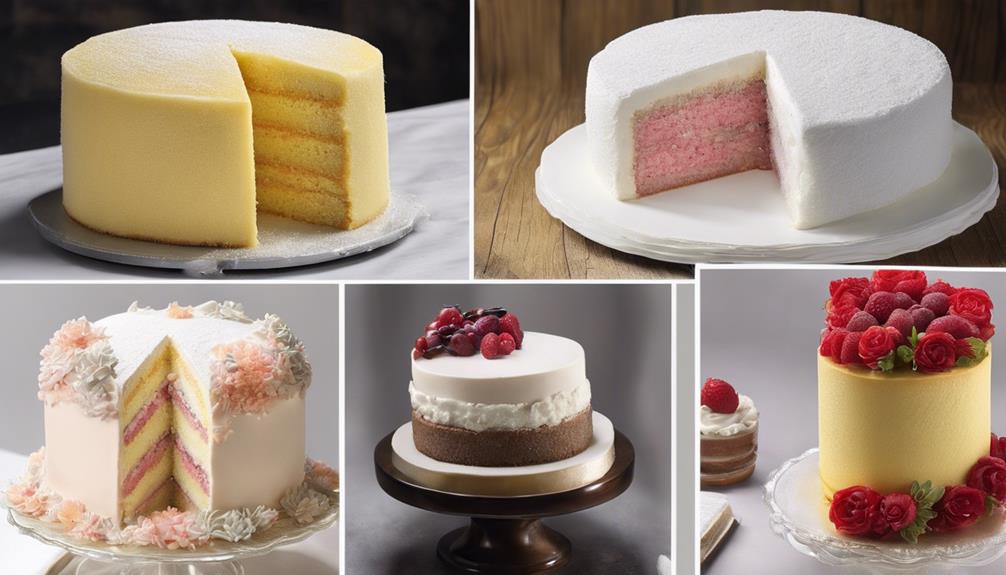
Considering the key ingredients in sponge cake versus regular cake, the balance between butter and sugar plays a critical role in determining their distinct textures. Butter provides richness and moisture in regular cakes, leading to a denser texture due to its higher quantity. On the other hand, sugar is vital in sponge cakes, contributing to their light and airy structure.
To better understand how butter and sugar impact the characteristics of these cakes, let's compare their ratios in the table below:
| Aspect | Regular Cake | Sponge Cake |
|---|---|---|
| Butter | Higher amount | Lower amount |
| Sugar | Moderate amount | Higher amount |
| Texture | Denser | Light and airy |
The ratio of butter to sugar significantly varies between regular and sponge cakes, influencing not only the taste but also the overall texture. By grasping the interplay between these ingredients, one can distinguish between the unique qualities of sponge cakes and regular cakes.
Crumb Structure Differences
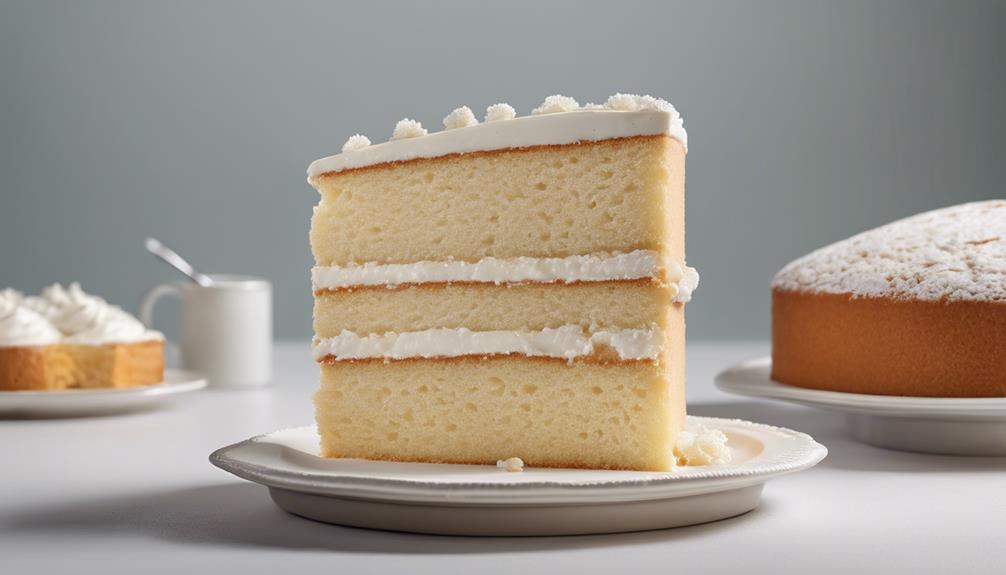
In understanding the nuances of cake textures, the crumb structure plays a pivotal role in distinguishing between sponge cakes and regular cakes. Here are some key differences to note:
- Light and Airy Crumb: Sponge cakes achieve a light and airy crumb structure by incorporating air from whipped eggs and sugar, resulting in a fluffy texture.
- Denser Crumb Structure: Regular cakes, such as white cakes, have a denser and firmer crumb structure with tighter, neater crumbs that offer a more substantial mouthfeel.
- Fluffy and Delicate: The crumb of a sponge cake is delicate, giving it a less dense texture compared to regular cakes, which can be more compact.
- Leavening Agents: Regular cakes often rely on baking powder or soda for leavening, contributing to their specific crumb structure and overall density.
Understanding these distinctions in crumb structure can help you identify the type of cake you're enjoying or aiming to bake.
Frosting Compatibility
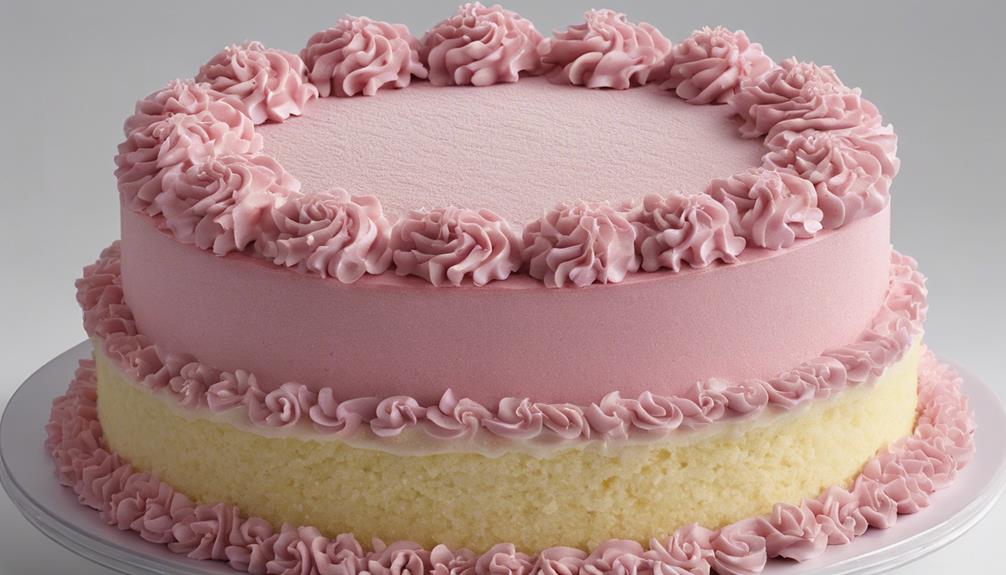
Exploring how different types of frosting complement the textures of sponge cakes and regular cakes reveals distinctive pairings that enhance the overall dessert experience. Sponge cakes, with their light and airy crumb structure, are best paired with lighter frostings like whipped cream or fruit-based options. These frostings complement the delicate texture of sponge cakes without overpowering them, creating a vital balance of flavors and textures.
On the other hand, regular cakes, known for their denser texture, pair well with heavier frostings such as buttercream or cream cheese. These richer frostings provide a decadent contrast to the sturdy structure of regular cakes, adding depth and richness to each bite.
When it comes to layered cakes, the lightness of sponge cakes makes them an ideal choice for multiple fillings and frostings. Their delicate nature allows for different flavors and textures to shine through in each layer. Regular cakes, with their sturdier composition, can withstand the weight of elaborate decorations and fondant, making them a popular choice for intricately designed cakes.
Choosing the right frosting for your cake plays an essential role in enhancing both the taste and presentation, ensuring a delightful dessert experience.
Frequently Asked Questions
What Is the Difference Between Regular Cake and Sponge Cake?
The difference between regular cake and sponge cake is that sponge cake contains no fat, giving it a light, fluffy texture. Regular cake, on the other hand, has added fats like butter or oil, resulting in a denser consistency.
What Are the 7 Types of Cakes?
Sure thing! There are 7 types of cakes, each with distinct flavors and textures. From rich butter cake to light angel food cake, they offer a range of delicious experiences. Exploring these varieties can truly enrich your baking adventures.
How Do Sponge Cakes Differ From Other Shortened Cakes?
When considering sponge cakes versus other shortened cakes, the key distinction lies in their fat content. Sponge cakes skip the fats, relying on eggs and sugar for structure, resulting in a delicate, airy texture different from richer counterparts.
What Is Unique About a Sponge Cake?
When I savor a slice of sponge cake, I'm struck by its airy lightness and delicate crumb. The magic lies in the whipped eggs and sugar, creating a fluffy texture unique to sponge cakes.
What Are the Key Differences in Decorating a Chocolate Cake Compared to a Sponge Cake?
When it comes to decorating a chocolate cake compared to a sponge cake, the key differences lie in the type of icing and toppings used. For the ultimate chocolate cake decor, rich and creamy chocolate ganache and chocolate shavings are ideal, while sponge cake may be better suited for lighter fruit fillings and whipped cream.
Conclusion
To sum up, while both sponge cake and regular cake share some similarities, they also have key differences that set them apart.
One interesting statistic is that sponge cake typically uses more eggs than regular cake, giving it a lighter and airier texture.
Understanding these distinctions can help you choose the right type of cake for different occasions or preferences.
So next time you're baking, keep these differences in mind to create the perfect dessert!

